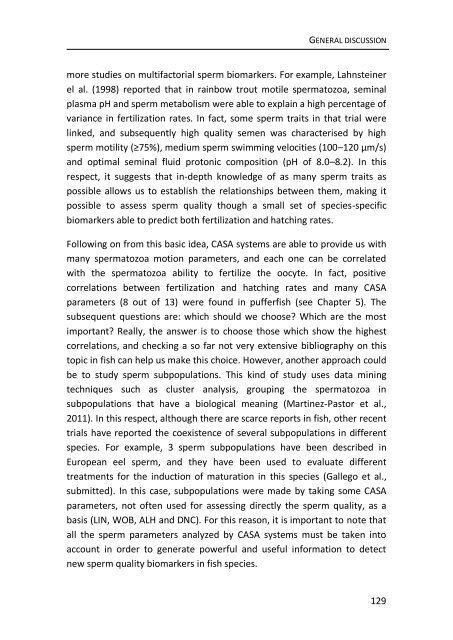chapter 3 - RiuNet
chapter 3 - RiuNet
chapter 3 - RiuNet
Create successful ePaper yourself
Turn your PDF publications into a flip-book with our unique Google optimized e-Paper software.
GENERAL DISCUSSION<br />
more studies on multifactorial sperm biomarkers. For example, Lahnsteiner<br />
el al. (1998) reported that in rainbow trout motile spermatozoa, seminal<br />
plasma pH and sperm metabolism were able to explain a high percentage of<br />
variance in fertilization rates. In fact, some sperm traits in that trial were<br />
linked, and subsequently high quality semen was characterised by high<br />
sperm motility (≥75%), medium sperm swimming velocities (100–120 μm/s)<br />
and optimal seminal fluid protonic composition (pH of 8.0–8.2). In this<br />
respect, it suggests that in-depth knowledge of as many sperm traits as<br />
possible allows us to establish the relationships between them, making it<br />
possible to assess sperm quality though a small set of species-specific<br />
biomarkers able to predict both fertilization and hatching rates.<br />
Following on from this basic idea, CASA systems are able to provide us with<br />
many spermatozoa motion parameters, and each one can be correlated<br />
with the spermatozoa ability to fertilize the oocyte. In fact, positive<br />
correlations between fertilization and hatching rates and many CASA<br />
parameters (8 out of 13) were found in pufferfish (see Chapter 5). The<br />
subsequent questions are: which should we choose? Which are the most<br />
important? Really, the answer is to choose those which show the highest<br />
correlations, and checking a so far not very extensive bibliography on this<br />
topic in fish can help us make this choice. However, another approach could<br />
be to study sperm subpopulations. This kind of study uses data mining<br />
techniques such as cluster analysis, grouping the spermatozoa in<br />
subpopulations that have a biological meaning (Martinez-Pastor et al.,<br />
2011). In this respect, although there are scarce reports in fish, other recent<br />
trials have reported the coexistence of several subpopulations in different<br />
species. For example, 3 sperm subpopulations have been described in<br />
European eel sperm, and they have been used to evaluate different<br />
treatments for the induction of maturation in this species (Gallego et al.,<br />
submitted). In this case, subpopulations were made by taking some CASA<br />
parameters, not often used for assessing directly the sperm quality, as a<br />
basis (LIN, WOB, ALH and DNC). For this reason, it is important to note that<br />
all the sperm parameters analyzed by CASA systems must be taken into<br />
account in order to generate powerful and useful information to detect<br />
new sperm quality biomarkers in fish species.<br />
129
















